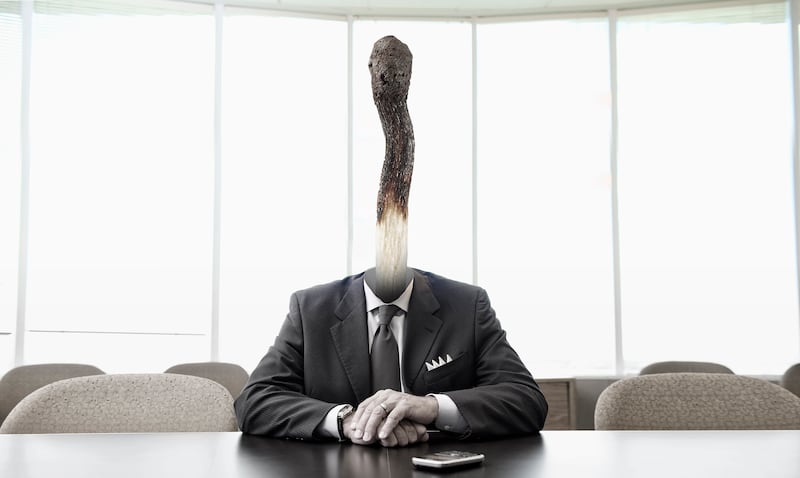Do you feel more irritable or forgetful at work? Or as though you’ve lost your motivation? Has it become harder to get a good night's sleep? Or do you get sick more easily?
While it might be easy to brush these symptoms aside, collectively, they may be a sign that you are experiencing burnout.
The World Health Organisation, which only began recognising the condition in 2019, says burnout is caused by chronic, unmanaged stress. While there are various types, burnout in the workplace is one of the most common.
According to US employment site Indeed, of 1,500 employees surveyed in the US last year, 52 per cent said they were experiencing burnout, up from 43 per cent pre-pandemic.
The UK didn’t fare any better as research from LumApps this year found 89 per cent of people felt burnout at least once, with 37 per cent reporting they felt it occasionally and 12 per cent saying they feel it all the time.
“My burnout began a long time before I realised what was happening," says Bianca Topham, who worked as a freelance photographer in the UK. "It started during my university years when I burnt the candle at both ends. I worked feverishly close to deadlines, whilst travelling for two hours every single weekend to be closer to friends and family.”

While Topham's job came with a glitzy lifestyle in London, she also had high levels of stress and a blurred work-life balance, inevitably leading to her feeling completely burnt out.
“I tried for a year to keep up my fast-paced rhythm and tried to do it all alone, but I became more confused and sank deeper into poor health. I was overwhelmed, lonely and felt like a failure. I desperately wanted a quick fix to get back to how things were, but I didn’t have any answers as to how to bring back my motivation, health, and physical and emotional energy,” she says.
Topham is now a wellness and burnout coach in Seville, Spain, advising clients around the world about how to tackle their stress to avoid the condition. She's learnt more about stress, which she says can sometimes be a good thing if properly managed.
“A certain degree of stress is a normal part of life, and can provide change, motivation and action,” she says. “With stress, there is a sense of urgency and our emotions can be overactive. Stress is often due to short-term situations, so you can recover from it with certain management techniques.
“However, if the stress is extreme, if it’s a part of our everyday life and if it’s not resolved, it can become chronic. Not everyone can deal with it and function when there’s such a strain on their physical and mental well-being.”
Here’s everything you need to know about burnout including its symptoms, recovery and preventive solutions, as the global community marks World Mental Health Day.
What is burnout and its symptoms?
The term “burnout syndrome” was coined by American psychologist Herbert Freudenberger in the early 1970s, to describe what he was feeling after working long hours at his private practice, as well as a second shift at another clinic.
He defined the condition as a “state of mental and physical exhaustion caused by one's professional life”, and later created burnout phases with a colleague.
The 12 stages were listed as:
- The compulsion to prove oneself: a person constantly feels they have to demonstrate their worth
- Working harder: an inability to switch off
- Neglecting needs: erratic sleeping, eating disrupted, lack of social interaction
- Displacement of conflicts: a person blames others or their situation for all their problems, including stress level
- Revision of values: friends and family are no longer as important and hobbies are dismissed. Work is the only focus
- Denial of emerging problems: intolerance; perceiving collaborators as stupid, lazy, demanding or undisciplined; cynicism, aggression; problems are viewed as caused by time pressure and work
- Withdrawal: social life small or non-existent
- Odd behavioural changes: changes in conduct, including impatience, aggression and snapping at friends and family
- Depersonalisation: feeling detached — a person will not see themselves nor others as valuable
- Inner emptiness: feeling empty inside
- Depression: feeling lost and unsure; exhausted; and like the future is bleak and dark
- Burnout syndrome: total mental and physical collapse; time for full medical attention
“Basically, people who are burnt out are exhausted, feel quite negatively about their job, and no longer have a sense of satisfaction or derive a feeling of accomplishment from the work they do,” says Dr Sarah Rasmi, a psychologist and founder of Thrive Wellbeing Centre in Dubai.
“People can also experience burnout when they feel they have very little control over their own lives, or if they're living or working in a way that is incongruent with their personal values.”

While symptoms will vary among people, signs include irritability, anxiety, digestive issues, sleeping problems, social withdrawal, forgetfulness and demotivation.
The condition can also take a physical toll, with problems arising in the form of headaches, fatigue and nausea. People going through burnout may also have lowered immunity and recurring bouts of illness.
How to recover from burnout?
“Recovery can be very slow, and no one shoe fits all,” says Topham. “But changes do need to be made as soon as possible, whether big or small.”
Rasmi says some steps towards recovery include holding realistic expectations, being more compassionate towards oneself when things don’t go to plan and establishing boundaries at work.
She also emphasises the power of psychological and professional self-care.
“Psychological self-care is about feeling, expressing and managing our emotions. We can promote this by devoting time to our hobbies, expressing our feelings by sharing them with others, or through creative means, such as taking time off work and other responsibilities, and generally laughing and having fun,” she says.
“Professional self-care is about learning and developing. It can include taking new courses, making time to connect with others, learning from colleagues, and maintaining a clean and organised workspace.”
Rasmi suggests that burnout is problematic not only at the individual level, but the organisational one as well as it can affect more than just the employee.
“Burnt-out employees are more likely to quit, be absent, have a workplace accident and have a weak emotional connection to their workplace. Together, this results in skills loss, recruitment costs, lost productivity and compensation costs.”
For Topham, she needed to leave not only her job, but essentially her life in the UK behind to begin her road to recovery.

“I finally accepted I needed to make very big changes in my life, not only on the outside, but the inside, too. So I started by moving to Spain to be closer to my family for support. I started to focus my energy on the best choices for my well-being; my health became No 1 in my decision-making,” she says.
Although she calls it an “extremely slow journey”, she is thankful for the experience. Leaving behind her friends, connections and a London home to move to Spain wasn't an easy decision, but she began to build a new life for herself, a process that started with a different mindset.
“For me, burnout was a combination of my personality, lifestyle, past experiences and exterior factors, but I see it can happen to anyone. If that is you, you do not need to live with burnout or unhealthy stress levels. In my experience, there is always a solution to our problems,” Topham says.
“Feeling refreshed, energised and inspired is something we all deserve and, with the right support, can achieve.”







